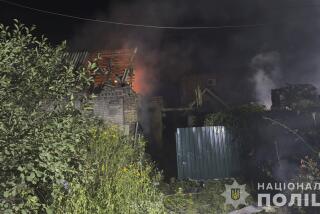U.S. Apparently Underestimated Size of Insurgency, Top Commander Says
BAGHDAD — U.S. forces killed or captured about 15,000 suspected militants in Iraq last year, the top U.S. commander in the country said Wednesday, suggesting that the American military has underestimated the strength of the insurgency.
The new figures seemed to show that previous estimates of an insurgent force of 6,000 to 9,000 fighters were inaccurate, Army Gen. George W. Casey said in a rare meeting with the U.S. media here.
However, Casey described as inflated a recent estimate by Iraq’s intelligence chief that the insurgency numbered as many as 40,000 hard-core fighters, or 200,000 when part-time combatants and sympathizers were included.
“It’s not a number I would subscribe to,” said Casey, a four-star general who is in charge of more than 150,000 U.S. and other coalition troops.
The size of the insurgency has become a matter of debate as the war continues and casualties mount on both sides. Like other top U.S. officials in recent days, Casey declined to provide a fresh estimate of the size of the rebel force.
The reluctance reflects in part a lack of solid intelligence about the fighters. The insurgency has become “better organized” in recent months, Casey said, though U.S. commanders say it still lacks a central command.
The top general predicted a successful election Sunday, even though the U.S. expects insurgents to mount attacks on voters and polling stations.
In the long term, Casey said, the only way to win the war is to muster effective Iraqi security forces. That will take time: Iraqi police units ran away recently in the face of insurgent threats in the cities of Mosul and Ramadi.
“We can’t stay in front on this over the long haul and be successful,” Casey said. “We’re viewed by the people ... as an occupation force.”
Casey reiterated what has become the military’s consensus: that the insurgency is largely home-grown and fueled by resentment among Iraq’s Sunni Muslim minority. Former Saddam Hussein loyalists, he said, hope to revive “Sunni dominance” in Iraq.
Sunnis lost that status after U.S. forces toppled Hussein, a Sunni who brutally repressed Iraq’s Shiite Muslim majority and its Kurdish minority. Sunni clerics and political leaders have launched a boycott of the election.
Casey said foreign fighters in the country probably number no more than 1,000 -- a tenth or less of the rebel force, by conservative estimates. That goes against an assertion made by some U.S. officials that religious militants from around the Muslim world are behind the insurgency.
More to Read
Sign up for Essential California
The most important California stories and recommendations in your inbox every morning.
You may occasionally receive promotional content from the Los Angeles Times.










